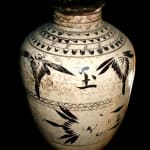Yuan Cizhou Ware Wine Jar, 1350 CE - 1450 CE
Terracotta
26.25
PF.5518
Further images
The Yuan Dynasty was established by Kublai Khan, the grandson of Genghis Khan, upon relocating the capital of his empire from Mongolia to Beijing. The Forbidden City was constructed, a...
The Yuan Dynasty was established by Kublai Khan, the grandson of Genghis Khan, upon relocating the capital of his empire from Mongolia to Beijing. The Forbidden City was constructed, a relative oasis of Mongolian culture in the heart of China. While the Mongol elite retained their native language and customs, they did adapt the Chinese system of bureaucratic government and cemented the authoritarian rule of the emperor. Although they were unaffected by Chinese culture, the Yuan did little to stifle the native traditions and beliefs of their subjects. Buddhism continued to flourish, although the monasteries received little funding from the state. In fact, during the Yuan Dynasty, China first began to open up to foreigners. Christian and Hindu missionaries were established in Beijing and Marco Polo made his famous journey during the Yuan era. While the Chinese never accepted the Yuan as a legitimate dynasty, instead viewing them as foreign bandits, the Mongolians rebelled against the Beijing Khans for becoming, “too Chinese.” In the end, the Yuan Dynasty had the shortest duration of the major Chinese Dynasties, lasting little more than a hundred years.
The term, “Cizhou,” denotes a particular type of ceramics ware. Named after the Cizhou province where examples were first unearthed, there have also been ruins of related kilns discovered in the Hebei and Henan provinces. While Cizhou ware was first created during the Five Dynasties, it only became popular during the Song and Yuan Dynasties, after which point production ceased. Cizhou wares are celebrated for their great variety of decorative motifs characterized by bold, expressive patterns with painterly qualities that can almost be called calligraphic. The free, expressive nature of Cizhou ware might be a reflection of the fact that they were created for the public and not intended for court consumption where tastes tended to be more refined. While the production of Cizhou ware was short-lived, its emphasis on decoration would affect the course of future ceramic production in China.
Formed with a rolled rim to the cylindrical neck and an elongated ovoid body tapering inward above the flat base, the tan fabric covered with a colorless glaze over white slip painted in iron brown pigments with a wide feathery leaf band beneath narrower wavy line, bands above and below inscriptions on the shoulder.
The term, “Cizhou,” denotes a particular type of ceramics ware. Named after the Cizhou province where examples were first unearthed, there have also been ruins of related kilns discovered in the Hebei and Henan provinces. While Cizhou ware was first created during the Five Dynasties, it only became popular during the Song and Yuan Dynasties, after which point production ceased. Cizhou wares are celebrated for their great variety of decorative motifs characterized by bold, expressive patterns with painterly qualities that can almost be called calligraphic. The free, expressive nature of Cizhou ware might be a reflection of the fact that they were created for the public and not intended for court consumption where tastes tended to be more refined. While the production of Cizhou ware was short-lived, its emphasis on decoration would affect the course of future ceramic production in China.
Formed with a rolled rim to the cylindrical neck and an elongated ovoid body tapering inward above the flat base, the tan fabric covered with a colorless glaze over white slip painted in iron brown pigments with a wide feathery leaf band beneath narrower wavy line, bands above and below inscriptions on the shoulder.











